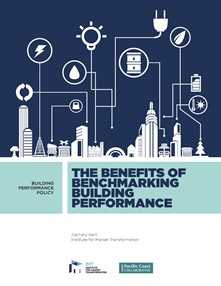It is relatively easy to make the connection that tracking and disclosing a building’s energy usage will promote energy savings, but in fact, there are many other benefits that go far beyond simply kilowatt hours. While benchmarking brings building owners’ attention to energy efficiency, resulting in behavioral and operational changes that spur immediate and low-cost reductions in energy consumption, these policies also provide the opportunity for increased government efficiency, job creation, and economic and environmental health.
IMT’s new Benefits of Benchmarking report, produced in support of our partnership with the Pacific Coast Collaborative (PCC), highlights the positive effects that can be achieved through benchmarking and transparency policies. The report comes at a time when a growing number of jurisdictions in the U.S. are enacting these policies to address a critical information gap. When buildings are uniformly benchmarked—meaning their energy use is measured on a consistent basis—and that information is shared publicly, the real estate market is empowered to consider and recognize the value of energy efficiency.
